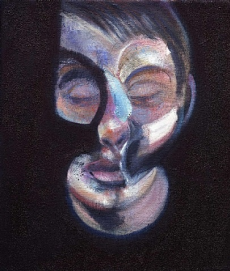
Email: emanuelealbertocirello.98@gmail.com
Total Article : 76
About Me:I am a Year 13 student which aspires to be an architect. I am interested in anything I don't yet know, and I mostly write about art, politics , Italian culture and inspirational people, although I will try to write for as many categories possible, just to test myself and get to know more things.

“Portrait of Lucian Freud” is an oil painting by Bacon, and it has been made in the 40’s, after he came back to London and met Lucian Freud, which is the subject of the portrait. The artist has used oil colours on canvas, making the composition fluid and homogenous.
The composition is made up by gentle curved lines which don’t disturb the viewer’s eye and make the painting quite harmonious. This shows that the painting has been made during the artist’s early career, as it doesn’t have the same crude, raw and disturbing features which can be seen for example in the other work which I have analysed. It has quite a rough texture, and despite the presence of a plain background, the figure still seems to emerge off of it, creating a quite visible contrast. The composition of the subject’s face is quite elaborate, as the distortion applied shapes the figure and consequently creates patches of colours moving along with the distortion. The work’s composition is therefore very dynamic as it creates movement through curvilinear composition, meaning that the curvy lines which distort the subject’s figure successfully create an idea of movement.
The colours used are not very saturated, but they are however luminous as they stand out from a plain black background. The palette used by the artist is not very wide as Bacon has used mainly cold tones for the representation of the subject. Shades of blue, peach, purple and white alternate themselves and are surrounded by a black background. The colours used are obviously not descriptive, as it is used to create a very stern and sombre mood. There are colour patches with visible blocks of blue, but this however doesn’t affect the harmony of the painting, because even though the colour themselves don’t seem to blend, the blocks of colours seem to due to the distortion forced by the black background.
There isn’t a very convincing depth in the painting, as there is no perception of space at all in my opinion. This is because all that is visible is the figure of Freud, who is only delineated by the dark background and nothing else. There is no sense of depth as there is no visible aerial perspective, or for that matter, any perspective at all.
The light used by the artist is very important as it is directly pointed at the subject’s face. The light source is in front of the subject, and therefore it is not depicted. Light emphasises the texture of the painting but most importantly it highlights the way Freud’s face is distorted. It therefore picks up the important elements of the composition and contributes with the use of colours with the setting of the mood.
The forms which are depicted through the use of light are curved and soft, and they seem quite sculptural in the way they are composed. The form of this artwork suggests that it belongs to an early stage of Bacon’s career due to the simplistic type of transformation applied to the subject. This is evident due to the difference there is with more complex portraits, such as the ones of George Dyer. This can be therefore show the development of the artist’s style and his more distorted nature, which develops as he keeps living.
This can therefore show how through life experiences, an individual’s mind becomes more and more affected by them, and develops some form of “response”. Francis Bacon has responded to the positive and negative experiences in his life by creating visions of distorted face, as reflection of a distorted self, perhaps. In “Study of Lucian Freud” this type of inner distortion of the artist’s mind is in a very early stage, as shown by the very simplistic nature of the artwork which can be used as a reference in order to analyse the path of the artist’s life and see how with time progressing, his art has become more complex and peculiar.
Image credits: http://www.artnet.com/artists/francis-bacon/portrait-of-lucian-freud-a-mNY8Yg-LiXUmZyYszDMkcQ2

0 Comment:
Be the first one to comment on this article.